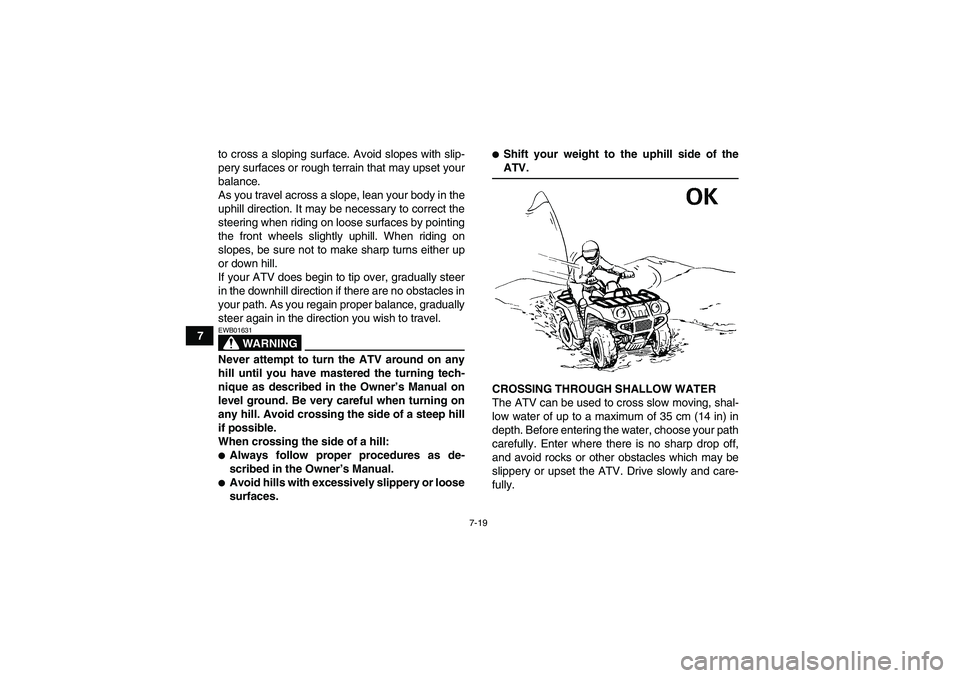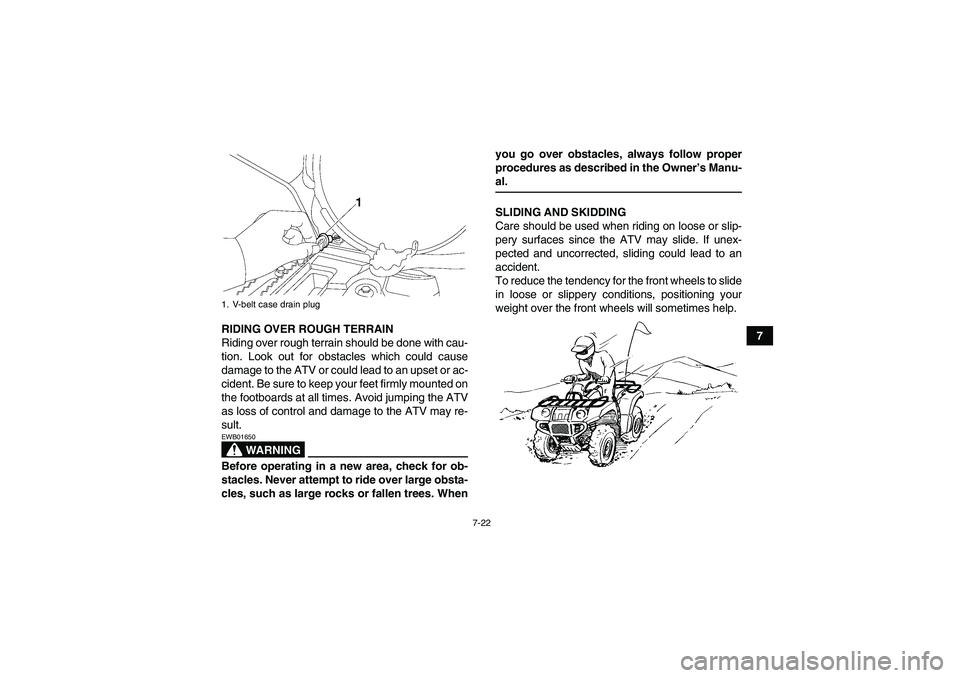Page 77 of 166

7-16
7
WARNING
EWB01600Never attempt to turn the ATV around on any
hill until you have mastered the turning tech-
nique as described in the Owner’s Manual on
level ground. Be very careful when turning on
any hill. Avoid crossing the side of a steep hill
if possible.
When crossing the side of a hill:�Always follow proper procedures as de-
scribed in the Owner’s Manual.�Avoid hills with excessively slippery or loose
surfaces.�Shift your weight to the uphill side of theATV.If your ATV has stalled or stopped and you believe
you can continue up the hill, restart carefully to
make sure you do not lift the front wheels which
could cause you to lose control. If you are unable
to continue up the hill, dismount the ATV on the up-
hill side. Physically turn the ATV around and then
descend the hill.
If you start to roll backwards, DO NOT apply either
brake abruptly. If you are in 2WD, apply only the
front brake. If you are in 4WD or 4WD-LOCK, be-
cause all wheels are interconnected by the drive
train, applying either brake will brake all wheels,
therefore, avoid sudden application of either the
front or rear brake as the wheels on the uphill side
U3B460E0.book Page 16 Friday, May 12, 2006 2:51 PM
Page 79 of 166

7-18
7 When this ATV is in 4WD or 4WD-LOCK, all
wheels (front and rear) are interconnected by the
drive train. This means that applying either the
front brake or the rear brake will brake all wheels.
When descending hills, using either brake lever or
the brake pedal will brake the wheels on the down-
hill side. Avoid sudden application of either the
front or rear brake because the wheels on the up-
hill side could come off the ground. Apply both the
front and rear brakes gradually.
Whenever possible, ride your ATV straight down-
hill. Avoid sharp angles which could allow the ATV
to tip or roll over. Carefully choose your path and
ride no faster than you will be able to react to ob-
stacles which may appear.
WARNING
EWB01620Always follow proper procedures for going
down hills as described in this Owner’s Manu-
al.
Note: a special technique is required when
braking as you go down a hill.�Always check the terrain carefully before
you start down any hill.�Shift your weight backward.�Never go down a hill at high speed.
�Avoid going down a hill at an angle that
would cause the ATV to lean sharply to one
side. Go straight down the hill where possi-ble.
CROSSING A SLOPE
Traversing a sloping surface on your ATV requires
you to properly position your weight to maintain
proper balance. Be sure that you have learned the
basic riding skills on flat ground before attempting
U3B460E0.book Page 18 Friday, May 12, 2006 2:51 PM
Page 80 of 166

7-19
7to cross a sloping surface. Avoid slopes with slip-
pery surfaces or rough terrain that may upset your
balance.
As you travel across a slope, lean your body in the
uphill direction. It may be necessary to correct the
steering when riding on loose surfaces by pointing
the front wheels slightly uphill. When riding on
slopes, be sure not to make sharp turns either up
or down hill.
If your ATV does begin to tip over, gradually steer
in the downhill direction if there are no obstacles in
your path. As you regain proper balance, gradually
steer again in the direction you wish to travel.
WARNING
EWB01631Never attempt to turn the ATV around on any
hill until you have mastered the turning tech-
nique as described in the Owner’s Manual on
level ground. Be very careful when turning on
any hill. Avoid crossing the side of a steep hill
if possible.
When crossing the side of a hill:�Always follow proper procedures as de-
scribed in the Owner’s Manual.�Avoid hills with excessively slippery or loose
surfaces.
�Shift your weight to the uphill side of theATV.
CROSSING THROUGH SHALLOW WATER
The ATV can be used to cross slow moving, shal-
low water of up to a maximum of 35 cm (14 in) in
depth. Before entering the water, choose your path
carefully. Enter where there is no sharp drop off,
and avoid rocks or other obstacles which may be
slippery or upset the ATV. Drive slowly and care-
fully.
U3B460E0.book Page 19 Friday, May 12, 2006 2:51 PM
Page 83 of 166

7-22
7 RIDING OVER ROUGH TERRAIN
Riding over rough terrain should be done with cau-
tion. Look out for obstacles which could cause
damage to the ATV or could lead to an upset or ac-
cident. Be sure to keep your feet firmly mounted on
the footboards at all times. Avoid jumping the ATV
as loss of control and damage to the ATV may re-
sult.
WARNING
EWB01650Before operating in a new area, check for ob-
stacles. Never attempt to ride over large obsta-
cles, such as large rocks or fallen trees. Whenyou go over obstacles, always follow proper
procedures as described in the Owner’s Manu-
al.
SLIDING AND SKIDDING
Care should be used when riding on loose or slip-
pery surfaces since the ATV may slide. If unex-
pected and uncorrected, sliding could lead to an
accident.
To reduce the tendency for the front wheels to slide
in loose or slippery conditions, positioning your
weight over the front wheels will sometimes help.
1. V-belt case drain plugU3B460E0.book Page 22 Friday, May 12, 2006 2:51 PM
Page 84 of 166

7-23
7If the rear wheels of your ATV start to slide side-
ways, control can usually be regained (if there is
room to do so) by steering in the direction of the
slide. Applying the brakes or accelerating is not
recommended until you have corrected the slide.
With practice, over a period of time, skill at con-
trolled sliding can be developed. The terrain
should be chosen carefully before attempting such
maneuvers, since both stability and control are re-
duced. Bear in mind that sliding maneuvers should
always be avoided on extremely slippery surfaces
such as ice, since all control may be lost.
WARNING
EWB01661Learn to safely control skidding or sliding by
practicing at low speeds and on level, smooth
terrain.
On extremely slippery surfaces, such as ice,
go slowly and be very cautious in order to re-
duce the chance of skidding or sliding out ofcontrol.
WHAT TO DO IF...
This section is designed to be a reference guide
only. Be sure to read each section on riding tech-
niques completely.
WHAT TO DO...�If your ATV doesn’t turn when you want it to:
Bring the ATV to a stop and practice the turning
maneuvers again. Be sure you are putting your
weight on the footboard to the outside of the
turn. Position your weight over the front wheels
for better control. (See page 7-13.)�If your ATV begins to tip while turning:
Lean more into the turn to regain balance. If nec-
essary, gradually let off the throttle and/or steer
to the outside of the turn. (See page 7-13.)
U3B460E0.book Page 23 Friday, May 12, 2006 2:51 PM
Page 89 of 166

8-4
8
6*Rear brakeCheck operation and correct if necessary.
Check brake pedal free play and adjust if neces-
sary.
Check fluid level and ATV for fluid leakage, and
correct if necessary.√√√√√
Replace brake pads. Whenever worn to the limit
7*Brake hosesCheck for cracks or other damage, and replace if
necessary.√√√√
Replace. Every 4 years
8*Rear brake hose
protectorsCheck for wear, cracks or other damage, and re-
place if necessary.√√√√√
9*WheelsCheck runout and for damage, and replace if nec-
essary.√ √√√
10*TiresCheck tread depth and for damage, and replace if
necessary.
Check air pressure and balance, and correct if
necessary.√ √√√
11*Wheel bearingsCheck for looseness or damage, and replace if
necessary.√ √√√
12*Upper and lower
arm pivotsLubricate with lithium-soap-based grease.√√√
13*V- b e l tCheck for wear, cracks or other damage, and re-
place if necessary.√ √√√
14*Drive shaft univer-
sal jointLubricate with lithium-soap-based grease.√√√ NO. ITEMCHECK OR MAINTENANCE
JOBINITIAL EVERY
Whichev-
er comes
firstmonth136612
km
(mi)320
(200)1200
(750)2400
(1500)2400
(1500)4800
(3000)
hours 20 75 150 150 300
U3B460E0.book Page 4 Friday, May 12, 2006 2:51 PM
Page 130 of 166
8-45
8
NOTE:The wheels need to be removed to check thebrake pads. (See page 8-62.)
Front brakeRear brake
EBU27842Checking the rear brake hose protec-
tors The rear brake hoses protectors must be checked
for wear at the intervals specified in the periodic
maintenance and lubrication chart. Each brake
hose protector is provided with a wear indicator. If
a protector wears to the point that its indicator be-
comes visible, have a Yamaha dealer replace the
protector.
1. Wear indicator groove
1. Wear indicator groove
U3B460E0.book Page 45 Friday, May 12, 2006 2:51 PM
Page 131 of 166
8-46
8
NOTE:The wheels need to be removed to check thebrake hose protectors. (See page 8-62.)EBU24251Checking the brake fluid level Insufficient brake fluid may allow air to enter the
brake system, possibly causing it to become inef-
fective.Before riding, check that the brake fluid is above
the minimum level mark and replenish if neces-
sary. A low brake fluid level may indicate worn
brake pads and/or brake system leakage. If the
brake fluid level is low, be sure to check the brake
pads for wear and the brake system for leakage.
Front brake1. Rear brake hose protector
2. Wear indicator
3. Protector is normal.
4. Protector is worn.
1. Minimum level mark
U3B460E0.book Page 46 Friday, May 12, 2006 2:51 PM